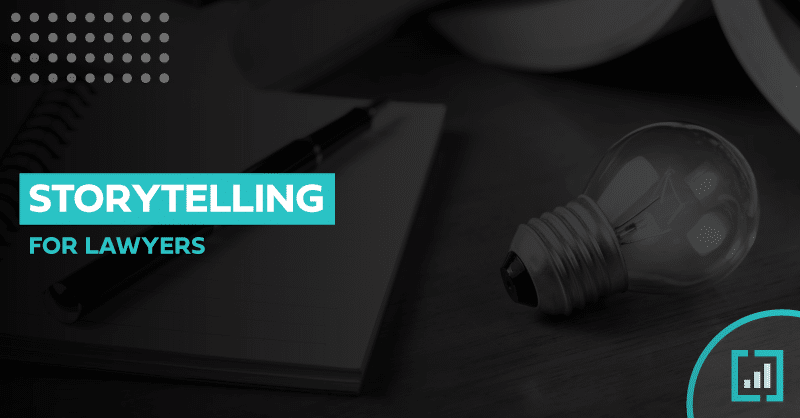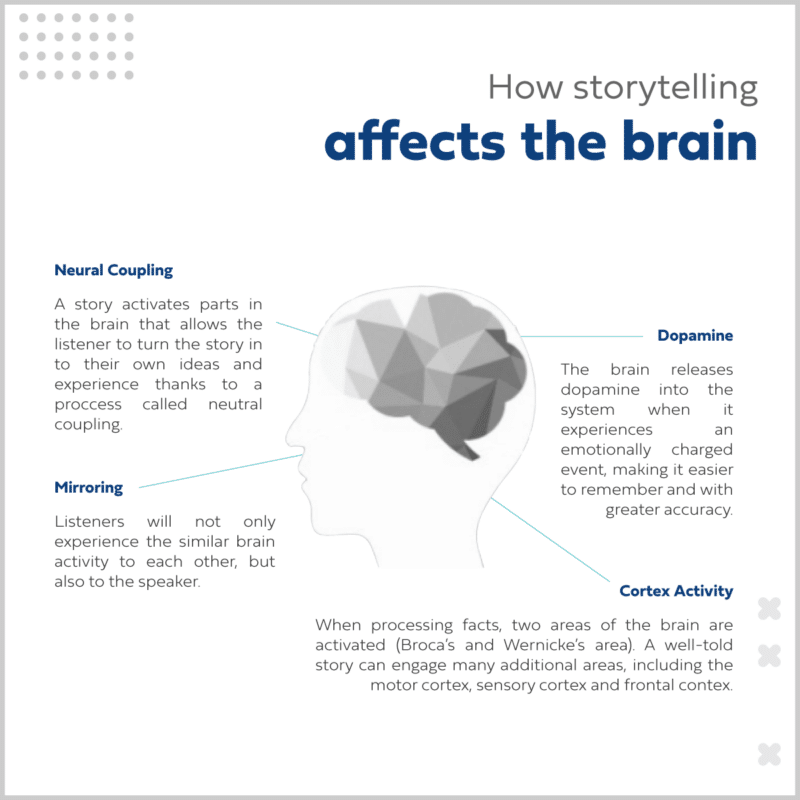
According to Lisa Cron, from Wired for Story, “Stories allow us to simulate intense experiences without having to actually live through them. Stories allow us to experience the world before we actually have to experience it.”
‘Significant Objects’ was an experiment devised by Rob Walker and Joshua Glenn. The purpose of it was to demonstrate the power of stories. In short, they went on their computer, purchased 200 objects with the criteria of each being $1.25 on average, and spent a total of $129. Then 200 contributing writers wrote short stories for the items, and do you want to know what the experimenters did?
They sold the items for around $8,000. That’s a 6,395% increase, and that is the power of storytelling!
So, what’s so great about stories? We’ll tell you in 4 simple words: people relate to them. Whether you’re watching a movie, an ad, reading a book, listening to a podcast, or even standing in front of the juror: stories are central players.
Since the beginning of time, we’ve been telling stories, and even if we don’t realize it, we also tend to think, remember, and talk in stories. In business, law firms included, building a strong narrative can be the differentiator between you and the rest. As humans, we are wired to respond to narratives. It is the best way to capture attention, retain information, build relationships, and more.
Does that mean that only professional writers are storytellers? Not at all! As a matter of fact, lawyers are superb storytellers. They have to thread a storyline for the entire courtroom. What’s more, lawyers depend on stories told by their clients! In a way, you could say we’re all storytellers.
But why do we narrate events?
- To provide a direction around the unknown.
- To bring people together. If your story resonates, educates, and informs – you’ll build deeper connections. And this will lead to higher customer loyalty.
- To inspire. We can all relate to the tales of the heroes, the underdogs, and heartbreaks.
Storytelling, specifically business storytelling, is the art of sharing the experiences behind your brand, employees, customers, and advocates. Mastering this art is paramount to connecting with your audience. This is especially true for firms because people hire them based on trust.
Stick around and learn how to master the art of legal storytelling.
Everything you do in business has a narrative
That’s a fact. Everything in business involves a narrative: your website, your values, your case, etc. When implemented correctly, you can expect to:
- Make your firm relatable and simultaneously memorable.
- Gain a better understanding of your audience(s). You’ll be able to answer questions like: what’s the client looking for? Are they looking for the most affordable or best solution? How familiar are they with the legal process?
- Highlight your “Why.” With a compelling story, you’ll be able to communicate your unique value proposition across all your channels.
- Drives emotional connection. This is big! Why? Because people make emotional decisions. We’ll explain more in the upcoming chapters.
- Foster brand loyalty.
- Position you as a thought-leader, the guide, and ultimately the hero!
Is this something you aspire towards? Then we’ve got the formula that’ll set you up for success. To build a strong connection, you can follow the 5 C’s in storytelling:
- Circumstance: Set the scene. By doing this at the beginning, you’ll help users understand the narrative.
- Curiosity: Spark the reader’s interest with a hook at the beginning or really just anywhere. You’ll want to create a thirst for more.
- Characters: The human touch will always be key. By adding characters and faces, you’ll give the readers a person they’re able to root for. For example, in court, the ultimate hero is your client.
- Conversations: Although some people will want to see more numbers and statistics, most people tend to respond to conversations better.
- Conflict: Every hero goes through the hero’s journey where they face challenges that lead them to their ultimate transformation.
Besides following the 5 C’s, here’s a FREE checklist that can help you brainstorm epic stories around your firm’s vision and mission:
Values – what does your firm stand for? Why was it founded? Ultimately, how do its values reflect your values?
People – Who are the people behind your firm? What are their stories? What inspired them to join the legal profession? How do you connect with people in the language they understand best?
History – What is the narrative behind everything you do in the firm? How did your firm come to be? What problems do you feel are essential to solving?
Journey – What’s your firm’s current situation, and where do you see yourself in X amount of years?
Lessons in understanding human nature

In Harper Lee’s American literature classic, To Kill a Mockingbird, the fictional attorney Atticus Finch stands quite stern but fair – he represents morality.
He implements storytelling with empathy by stepping into his client’s shoes. He knows that’s he’s fighting an uphill battle with the court against him, but he valiantly tells the story using Aristotle’s 3 Pillars of Persuasion:
- Logos – (Facts) The proof provided in the persuasive argument.
- Ethos – (Character) Atticus’ poise as a fictional lawyer makes us believe he’s credible. Although some might argue this doesn’t matter, it’s quite the contrary. When the body language matches the story, it is even more powerful.
- Pathos – (Emotions) Refers to the emotions conveyed. What emotions do you want to stir?
It is no wonder the actor who plays the attorney, Gregory Peck, won an Academy Award for his performance in this movie. He also shot this 9-minute closing argument in one take.
Great acting, camera work, and most of all, a great story
The film “Philadelphia” is based on the true story of an attorney who sued one of the world’s largest law firms for firing him because he had AIDS. This snippet starts with the attorney’s opening statement in the courtroom. Do you want to know what makes Denzel Washington’s character such a great storyteller in this scene? Here are a few things we can learn:
- He starts by stating a fact from the get-go. In storytelling, beginning with a hook, a strong opinion, a shocking truth, or anything that catches attention is the key to a powerful intro.
- He then walks the trial judges through the pointers he’s going to elaborate on. In storytelling, this means guiding the readers to the message.
- At last, he eloquently plays into the jury’s emotions by showing them there’s a social lack of understanding of AIDS (in the 90s).
Take a look at Denzel Washington’s opening statement:
Emotional marketing sells

According to studies, we do not make decisions logically but rather emotionally. Do you know how we use our rational thought? Well, it turns out that we use it to argue the emotional position we took! In the end, emotions require less effort than logic. Mind-blowing, isn’t it?!
With just this fact alone, it’s clear to see that emotional marketing sells.
Often we think happiness is the ultimate destination or state of being. However, all emotions are valid and play a big role in storytelling. Joy, gratitude, interest, anger, love, altruism, fear, satisfaction, and relief are powerful emotions.
So, which emotions sell the most? The answer is, it depends. Like in storytelling and law, we take a position and then find arguments supporting that view. The trick is to identify the sentiment that best fits your message.
To find out which emotions work best, think back to this question: what do you want the reader to feel? According to Princeton neuroscientist Uri Hasson (as found in HBR), “a story is the only way to activate parts in the brain so that a listener turns the story into their own idea and experience.” This is called neural coupling.

Neuroscientists are still looking more into these findings. But, ultimately, when we dive into a story rich in details, data, expression, images, etc. – we put ourselves in that situation.
Touching on your prospect’s deep unspoken emotional needs converts more than you might think.
Storytelling Best Practices

- Define the core message. Whether your story is 10 seconds long or 10 pages long, the core message must be established before anything.
- When using emotional marketing, begin with something relatable and something your audience can agree with.
- Focus on building a hero-centric story structure. Today’s marketing is more client-centric than ever. Therefore, lawyers should position themselves as the guide who helps the client (the hero) find a solution to fix their problem.
- Use client testimonials. No one can communicate how terrific your firm’s services are better than those who have already experienced them.
- Build a strong connection by evoking your audience’s desires, dreams, and aspirations.
- Show you care by demonstrating empathy.
- Add case studies. There’s no better way to prove you can bring results than case studies. In them, you can:
- Tell the client’s story using the hero’s journey: hook, introduction, rising action, climax, and the ultimate resolution.
- Choose the story’s medium. This will depend on resources and budget.
- Publish it! If it involves the client’s information, make sure you get their permission beforehand. Once that’s taken care of, share and promote it! Creating is only half the battle. Sharing is the other half.
Emotional storytelling: the best way to build a connection

In our first part of Storytelling for Lawyers, we talked about how we as humans do not make decisions logically but rather emotionally. This proves that emotional marketing in storytelling fortifies deeper connections with others, and from a sales point of view, it sells.
Jebaily Law Firm knows how to connect with its audience using the power of emotions. Here’s how they implemented this:
- The managing partner, George Jebaily, starts by pointing out the pain points his customers face, e.g don’t know the system.
- Then, they build on trust by stating they’re there to help.
- Afterward, they provide the solutions to the pain points.
- In the end, the message is tied back to compassion by reinforcing the client isn’t alone and extending a helping hand.
Influence with stories backed up by social proof
Without a doubt, testimonials are influential for several reasons. If we’re speaking numbers, they help convert – they bump conversions on sales pages by 34%.
On the flip side, your clients also want to see social proof like this. They’re curious to know how others did and what they got out of it. More so, customers trust each other even if they don’t personally know each other. This is the secret behind successful testimonials:
- The foundation – In stories, there needs to be a conflict to overcome an obstacle. Why did the client seek out your firm? What problems were they facing?
- The journey – The character goes on a trip to solve the conflict. In this case, the client seeks the firm for solutions.
- The end – There are no rules except to have a clear objective in mind. Think back to the main goal of the video. Do you want to build awareness? Trust?
Jebaily Law Firm also has an excellent example of a client testimonial that follows this structure:
Share your story

Every tale told is designed with a purpose in mind. Whatever that purpose may be: convert, convince, persuade, and more – it’s paramount you share your stories.
Storytelling is an integral part of your entire legal strategy – from the courtroom to your ads. In a world where we’re constantly bombarded by information, a unique narrative can help you cut through the noise, stand out and most importantly, grab the attention of those that need you and vice versa, those you need.
If you’re looking to ensure your stories strike a chord with consumers time and time again, it’s possible. Our content experts are here to help.






